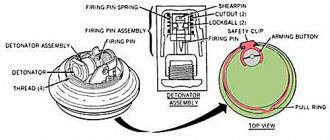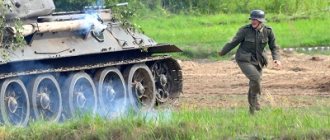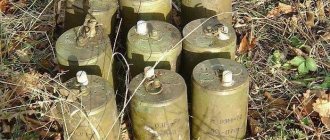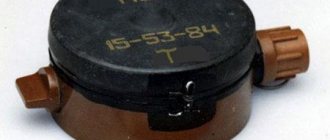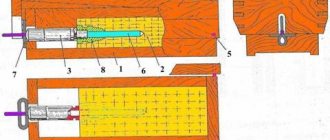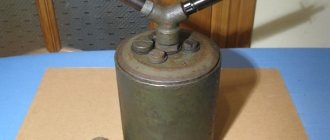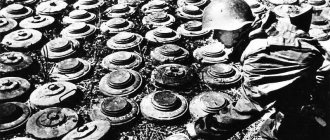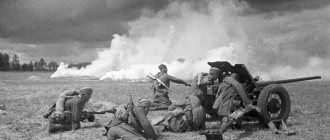US War in Vietnam (1965–75)
US War in Vietnam (1965–75)
The South Vietnam War, which began as a civil war back in 1959, spurred the development of anti-personnel mines. The forces of the South Vietnam Liberation Army (Viet Cong), who had no tanks, no other armored vehicles, no heavy weapons, no army aviation, compensated for the weakness of their infantry formations by waging war using guerrilla methods. At the same time, they made extensive use of minefields and non-explosive traps.[12]
The American professional knowledge “Mines and Booby Traps”, published in June 1969, admitted that in 1965, the losses of US Marine personnel to mines and traps in South Vietnam amounted to 67 to 75% of all losses. Even after all the measures taken in 1968, such losses were still 37.7%.
By the time of its creation and the start of active hostilities against the expeditionary force of American troops in March 1965, JSC NFO already had experience in fighting against the Japanese occupiers (1942–1945), against the French colonial army (December 1946–October 1954), against armed forces of the Republic of South Vietnam (1959-65).
A characteristic feature of all these wars was that the Liberation Army (Viet Cong) experienced an acute shortage of all types of weapons. Therefore, its fighters learned to use any available means as weapons, including various non-explosive traps.
The Vietnamese showed great ingenuity and skill in arranging a variety of crossbows, wolf pits, falling logs, stones, etc. No less ingeniously, they used unexploded American shells, aerial bombs, abandoned or lost ammunition as mines. They usually removed explosives from aerial bombs and shells, and the fuses, after minor modifications, were used as mine fuses. For mine casings, JSC fighters used any containers suitable for this purpose, from spent outboard fuel tanks abandoned by aircraft, empty fuel cans, packaging from supplies, and ending with empty Coca-Cola cans and boxes of dry rations. Spent cannon cartridges, even cartridges from heavy machine guns, were widely used.
It is no coincidence that in his order the commander of American forces in South Vietnam in May 1969 demanded the complete disposal of everything that the Vietnamese could use. It was forbidden to throw away even empty cigarette packs and used flashlight batteries.
This is how an American official publication describes mines made from tin cans:
TIN CAN ANTIPERSONNEL MINE
An anti-personnel tin mine can be made from sheet metal or from any discarded metal can (dry ration, beer or soft drink). The igniter for the explosive charge is an improvised igniter with zero delay time. The grenade fuse can be used after removing the delay element.
The mine is triggered by a tension wire attached to a pull ring. The tension in the wire pulls the pull ring, activating the mine in the same way as a hand grenade.”
American M26 and NZZ hand grenades were very popular in the joint-stock company, which they used as anti-personnel mines.
In addition to the well-known method of using a grenade as a tension mine, for example, they used it as a pressure mine. To do this, the grenade was coated with a thick layer of mud or clay and dried in the sun. When the dirt dried, the safety pin was removed from the grenade. The lever was held in place by dried mud. Such a mine (the Americans called it a “Mudball mine” - mud mine) was quietly placed on the path along which American soldiers walked. When an infantryman stepped on this lump, the mud crust was destroyed, the lever was released and the grenade exploded.
Author's note
Sawing down a grenade fuse detonator and removing the powder moderator from it is not a Chechen invention of the 1990s, but a Vietnamese invention of the 1960s. With such a fuse, the grenade exploded not in 4 seconds, but instantly.
TACTICAL EXAMPLE OF USING THE MUDBALL MINE
One mine is laid on a path along which a pair of Marine patrols pass every 20-30 minutes. Another mine was laid 100 meters ahead along the route. There is a Viet Cong in ambush 30 meters behind. American Marines follow at a distance of 15 meters from each other. Once the patrol has cleared the ambush, the Viet Cong places a second mine on the trail.
After a soldier is blown up by the first mine, the second soldier, knowing that the Viet Cong usually lay two or three more mines nearby, either opens automatic fire to kill, or turns and runs back to call for help. He is blown up by the second mine.
The sergeant, hearing the explosions, sends help along the path in the opposite direction. The second patrol runs into a third mine. The soldiers are dying from loss of blood, because after three explosions the lieutenant ordered to call sappers, who advanced to the victims for about 3 hours.
American casualties: two killed, one wounded.
Viet Cong casualties - no. Consumption min - 3 pieces.
The Vietnamese even managed to use the triggered American M2 jumping mines. They placed a black powder charge at the bottom of the cartridge case and ran a wire through it with an electric igniter at the end. A wooden tube, cut lengthwise, was inserted into the cartridge case, and a hand grenade was inserted into the tube. Then they pulled the pin.
The grenade lever was held by a tube. When the mine was triggered, the powder charge threw up the tube along with the grenade. In flight, the grenade lever was released and the fan exploded. The electric igniter for the powder charge was connected to the battery from the control panel, or through a simple contactor made of two tin plates on a wooden plank.
Vietnamese homemade mines "Mudball"
One of the Vietnamese homemade mines, which the Americans called “Toe Popper,” was a shell casing with a charge of black powder placed at the bottom and an igniter inserted. The rest of the sleeve was filled with metal fragments, and its top was sealed with bitumen.
The igniter was a bunch of matches (!), the heads of which were wrapped with a matchbox grater. A stick (peg) was inserted into the middle of the bundle, extending outwards. When the victim stepped on the stick, its downward movement caused the match heads to rub against the grater. The matches ignited. They ignited gunpowder, which threw up a bunch of fragments.
The leg wound, which in itself was not too serious, was aggravated by the powder burn and infection introduced into the wound. In a humid tropical climate, even such a wound required immediate evacuation of the victim to the hospital. So this primitive mine justified itself.
Author's note
In general, the “mosquito bite” tactic alone could not bring victory to the Liberation Army (Viet Cong), nor could it cause significant losses to the Americans. However, it greatly got on the nerves of American soldiers, who were accustomed to value their own lives and health above all else. The overcrowding of army hospitals with the wounded, who were by no means eager to return to combat formation as quickly as possible, had a depressing effect on the rest of the personnel.
The wounded soldiers actively sought to be recognized as disabled, sent home, and paid monetary compensation. They involved their families in the United States in this extortion, who began bombarding Congress and the White House with letters, complaints, and protests. The US public was frightened by the "enormous number of our crippled boys" and increasingly protested against the Vietnam War.
So all these primitive mines and traps had the main damaging factor - mine fear - no less than powerful factory-made mines.
Vietnamese match (!) igniter, called by the Americans “Toe popper”
JSC NFO, out of the entire world arsenal of anti-personnel mines that existed at that time, most often used Soviet wooden mines from the last war, PMD-6 (local handicraft production) and plastic Soviet PMN mines, nicknamed “Black Widow” by American soldiers.
What was unexpected for Soviet specialists was the desire of the Vietnamese to organize the supply of Soviet directed-destruction anti-personnel mines MON-100 and MON-200, after they were tested in South Vietnam. These mines, adopted by the Soviet Army in the early 1960s, were received very coolly by the troops. They found very limited use in the Soviet concept of mine warfare.
The main disadvantage of such mines was considered to be a very narrow affected area: 5 meters for MON-100 and 10 meters for MON-200. The mine had to be aimed very accurately, and it was quite difficult to determine from the control panel whether the enemy had entered the affected area.
The Vietnamese found that these mines were best suited for setting up ambushes on narrow roads in the jungle. A MON-type mine directed along the road hit an American infantry column to a depth of 100 or 200 meters.
The use of the MON-200 mine also turned out to be effective against unarmored vehicles. In Vietnam, these mines were designated DH-10. The Americans called them “VC Claymore”, i.e. “Wet Cong Claymore”.
Of the anti-tank mines, the Viet Cong most often used Soviet anti-tank mines from the Second World War TMB-2, TMD-B, TMD-44, TM-41, TM-44, TM-46, Chinese No. 4.
A good source of replenishment of the JSC's mine arsenals were the minefields laid by the Americans, from which the partisans removed as many mines as they needed at night.
The Americans' traditional disregard for anti-mine devices and poor surveillance of their minefields cost them dearly. It was possible to calculate that among all the losses of personnel to mines, the Americans lost up to 16% from their own mines, re-installed by the Vietnamese. The Australians received up to 50% of their total mine losses from such “stolen” mines.
General Westmoreland, commander of US forces in South Vietnam, once admitted that in the province of Phou Chau (Phouy Tuy) of the 20 thousand anti-personnel mines laid by the Australian contingent, more than 10 thousand were removed by the Viet Cong and again planted against Australian soldiers.
The American book on the experience of war (Professional Knowledge “Mines and Booby Traps”) admits that 90% of all materials needed to produce Viet Cong mines and traps were of American origin (thrown, lost, stolen, bought).
* * *
One of the main features of the Vietnam War was that there was no continuous or even definite front line. Hence the specific mining tactics used by JSC forces. They did not lay minefields with significant mine consumption, limiting themselves to laying groups of mines on roads and footpaths.
The following figures indicate how successful this tactic was and what role anti-tank mines played in it:
? on Highway No. 19 east of the city of Pleiku from January to March 1967, 89 different combat and transport vehicles were blown up, and another 27 mines were discovered and removed;
? in the northern tactical zone of the 3rd Army Corps from June 1969 to June 1970, 350 vehicles were blown up, another 750 mines were discovered and removed;
? analysis of losses in military equipment for the period from November 1968 to May 1969. showed that Viet Cong mines caused 73% of all tank losses and 78% of armored personnel carrier losses.
That is, the main, often the only anti-tank weapon of the Vietnamese were mines, and they caused considerable losses.
Author's note
This is the real reason why the West is so up in arms about mines. After all, this is a weapon of the weaker defending side, moreover, a very effective weapon, deadly in the right hands, capable of very significantly curbing the appetites of the aggressors.
Today and for the foreseeable future, Russia is a militarily weak country. Meanwhile, from the moment of its creation to the present day, NATO has never protected anyone anywhere from aggression. This organization itself was an aggressor, take, for example, the air and psychological war against Yugoslavia. So should we listen to this hypocritical anti-mine cry of various kinds of “humanists and human rights activists,” including their Russian backers?
The scope of the mine war of the NFO JSC became so great over time that, as the Americans themselves admit, it was necessary to check the entire road network for mines almost daily. At the same time, the use of mechanized means of trawling was often not possible, since plow digging trawls (very effective in themselves) actually destroyed the road surface, and it became unsuitable for wheeled vehicles.
The Americans never created good roller mine trawls. Only 27 copies of them were delivered to Vietnam, but they were not popular among the troops.
Detection dogs were somewhat more successful, but they, as it turned out, missed up to 16% of mines, and one dog could work effectively for no more than 1–2 hours. In addition, for a long time (until 1970) dogs were trained incorrectly. They were taught to detect the smell not of explosives, but of the bodies of the Vietnamese, which, according to American experts, stays in one place from one day to four. The arrogant “Yanks” did not care about the experience of using mine-detecting dogs by German, Finnish and Soviet sappers in World War II.
Soviet directional fragmentation mine MON-200
The program of rewarding local residents for reporting known facts of mining yielded only 0.6% of the total number of detected mines.
One of the ways to counter the mine actions of the Viet Cong was to search and destroy the so-called “mine factories,” that is, those places where the Vietnamese made homemade mines and traps. However, JSC units continuously moved the production of mines from place to place, focusing mainly on those places where there were quite a lot of ammunition, unexploded shells and bombs abandoned by the Americans. Launching the production of primitive mines in a new place was a matter of several hours.
The Vietnamese immediately responded to each new counter-mine action by the Americans with a new, more sophisticated method of mining.
Since the spring of 1969, Soviet TMK-2 anti-bottom cumulative mines began to be supplied to South Vietnam, as a result of which American losses in armored vehicles and personnel increased sharply. This mine, unlike anti-track mines, destroyed a tank or armored personnel carrier completely, along with its crew. Soldiers began to prefer to ride on the roofs of armored personnel carriers, believing that they suffered fewer casualties from sniper fire than from anti-bottom mines.
By 1969, American infantry casualties to antipersonnel mines accounted for 16 to 30 percent of all casualties. The commander of the 1st Marine Division reported that mines accounted for up to 75% of all personnel losses.
Thus, in the Vietnam War, mines became a decisive element in disabling American equipment and personnel.
The Americans partly solved the problem of counteracting mining through dense and constant patrolling of roads, installation of sensors along the roads that react to movement close to the road, harassing shelling of suspicious areas, constant patrolling of helicopters over roads and in a strip of terrain at a distance of 10–12 km in both directions from expensive However, they failed to completely solve this problem until the end of the war.
In the end, the command of the American troops found a way out in the massive use of helicopters to transport units, which at the first stage reduced American losses to mines to zero.
However, the Vietnamese were the first in the world to develop and introduce into combat practice the Cong Truong anti-helicopter mine. They installed these mines in places where helicopters were likely to land and where tactical troops would land. Actually, it was an improvisation from the American M16 anti-personnel shrapnel mine, in which the pressure fuse was replaced by a simple electrical contactor made of two tin plates. The air flow from the landing helicopter pressed one plate against the other, and then a sheaf of shrapnel from the exploding mine pierced the bottom of the helicopter, hitting the crew and fuel tanks.
It turned out to be even easier to use ordinary hand grenades against helicopters. Here's what the 1969 American professional publication (Professional Knowledge "Mines and Booby Traps") said:
“A 13-year-old Vietnamese boy recently detained claims that the Viet Cong forced him to scout helicopter drop sites. The boy was instructed by the Viet Cong how to place hand grenades in these locations with strings wrapped around the levers.
Pieces of paper must be attached to the free ends of the threads and the safety ring must be removed. The air flow from the landing helicopters picks up the paper, which, rotating, unwinds the thread and releases the safety lever.”
Of course, the effectiveness of such an anti-helicopter mine is low, but if the circumstances are successful, it is possible to damage a helicopter. And the main thing is that such improvised mines make pilots nervous and refuse to land at the slightest suspicion of the presence of mines. That is, they developed a “fear of mines” not only among the American infantry, but also among the flight personnel.
Author's note
It is worth noting that a helicopter pilot has a completely different psychology than an infantry soldier. For a pilot to be on the ground without his aircraft, that is, without his usual environment of action, this is a strong psychological stress. It is poorly adapted to actions on the ground and is more vulnerable. In addition, the pilot believes that ground combat operations do not concern him; it is more important to preserve the expensive winged aircraft.
Instead of losses in tanks, the Americans began to suffer losses in helicopters.
Later, the Vietnamese learned to use Soviet directed anti-personnel mines MON-100 and MON-200 against American helicopters. A beam of large shrapnel from the MON-200 mine reached the American Iroquois at distances of up to 150–180 meters. Typically, 3–5 mines were used simultaneously against helicopters, which sharply increased the probability of destruction.
In response, the Americans, since 1971, began to use a fundamentally new method of clearing helicopter landing sites - volumetric explosion bombs. When one such bomb exploded, it produced a shock wave with a power of 22 kg/sq. cm on an area of 182 sq. m. In this space, all vegetation was completely blown away and all the mines exploded. The helicopter landing became absolutely safe.
* * *
The development of anti-personnel mines, especially high-explosive mines, from the second half of the 1960s proceeded simultaneously in two directions: 1) along the path of minimizing the size of mines; 2) along the way, the creation of means of remote delivery and installation of mines.
Minimization of size was presented within the framework of the concept of “humanization of mine weapons.” They say that the purpose of anti-personnel mines is not to destroy enemy soldiers, but to incapacitate them through wounds.
However, in reality, minimization—reducing the mass of an explosive charge and the destructive power of mines—provides the following advantages:
? significantly reduces the cost of each mine;
? significantly increases the number of mines transported (carried) with the same total weight;
? simplifies the problem of mechanization and remote delivery of mines to places of application.
? allows you to achieve a greater density of minefields, which increases the likelihood of defeating enemy soldiers;
? makes it more difficult to find and clear mines;
? creates many problems for the enemy related to the evacuation of the wounded and the congestion of medical facilities;
? damage to the lower extremities by anti-personnel mines, as a rule, makes people disabled, incapable of either military service or full-time civilian work, which burdens the state budget with unproductive expenses for treatment, pensions and social security for disabled people;
? the appearance of a large number of war victims in the rear has an extremely negative impact on the morale of the entire population.
The first samples of mini-mines were intended for manual installation. These are British mines 5Mark1, 6Mark1, 7Mark1, American mines M14 and M25LC.
American mini mine M25LC
By the end of 1969, US troops and the government of South Vietnam had already lost control over vast territories of the country and could not effectively prevent the movement and concentration of AO (Viet Cong) units. This circumstance stimulated the growth of interest in the idea of remote mining of enemy communications from the air.
The idea itself was not new. As stated above, the Americans used a slightly modified German aviation system “Spreng Dickenwend-2” (SD-2) “Schmetterling” in Korea under the symbol AN-M83. At the same time, the US Marine Corps used (in 1952-53) the first air-dispersed anti-tank mine, the Douglas Model 31.
Various examples of air-launched mines
In Vietnam, the Americans remembered the SD-2/AN-M83 mine bomb and began to use it again. However, it soon became clear that this model was not entirely successful, since its wings often got stuck in the dense vegetation of the jungle and the mine did not reach the ground. The Americans urgently began to vary the basic model. They released a whole series of similar mines: BLU 2, BLU 3, BLU 24, BLU 26, BLU 61. Due to the rush in development, they all suffered from many shortcomings. The main thing is that most of them did not explode when they needed to. The Vietnamese collected many thousands of these mines and used them against the Americans.
The first production model of a remotely deployed anti-personnel high-explosive mine was a mine known as “Grevel”. It was a bag made of waterproof fabric, inside of which there was a mixture of hexogen and lead azide, placed between two plastic (or fiberboard) plates. There is no fuse in this mine, since lead azide is a very sensitive initiating explosive, and RDX is a fairly powerful high explosive.
Grevel mines were placed in cluster bombs of the SUU-41B/A type, in quantities from 1,470 to 7,500 pieces, depending on the specific brand of mine, and filled with freon, which played the role of a fuse. After the mines are ejected from the cassettes, the freon evaporates and the mines become pressure sensitive. When the foot of a person or animal steps on the bag, the explosive is compressed between the plates and an explosion occurs, causing injury to the foot.
But the effectiveness of this mine turned out to be low, just like the Fragmacord mine, which was a piece of detonating cord with metal rings put on it.
Soon, a small-sized high-explosive anti-personnel mine BLU-43/B “Dragontooth”, an analogue of the Soviet PFM-1 mine, entered service. One cassette contained 78 minutes. Up to 80 cassettes (6240 min) were suspended in containers on the sides of the helicopter. Mining was carried out by firing mines from cassettes. In order to prevent the accidental detonation of their soldiers on these mines, they were equipped with a self-destruction system, which ensured the explosion of the mine upon expiration of the deadline.
Following this, the US Army in Vietnam received the BLU 42/B mine, which was also installed using airplanes or helicopters.
* * *
The Arab-Israeli wars that took place in 1956, 1967, 1973 also showed that in modern warfare mines, when used skillfully, can provide significant results.
So, in 1956, in a battle near Aim Agela, an Israeli company in half-track armored personnel carriers ended up in a minefield. Half the cars were blown up by mines. The rest of the armored personnel carriers, which had lost the ability to maneuver, were shot by the Arabs from anti-tank guns. In 1967, the Israeli offensive in the Um Katah area was stopped almost exclusively by Egyptian mines.
In 1973, the Egyptian 25th Armored Brigade found itself sandwiched between a minefield and the positions of Israeli anti-tank weapons, as a result of which it was destroyed. Losses amounted to 86 tanks and all armored personnel carriers.
Story
"Claymore" (M18 mine) appeared in the 50s in the USA. The author of the design is engineer Norman McLeod.
During the Vietnam War, the American army was faced with the fact that the enemy began to actively use fragmentation mines. The Claymore was created for the US Marines. Initially, it was intended to protect key points and bases. Such mines were placed around the most important objects. If the enemy approached, the mines were detonated. In a word, powerful protection.
The mine was safe for its own soldiers because the explosion occurred at a distance. The Claymore showed high efficiency; with its help, it was possible to eliminate many enemy forces.
Stories related to M18
In the Soviet Union, in the 60s, an analogue of the M18 mine design, called MON-50, was created. Later, similar designs appeared in other states. For example, MRUD was released in Yugoslavia, Type 13 and Type 21 were released in Sweden.
Vietnamese soldiers during the war distinguished themselves by stealthily approaching assigned M18s and turning them towards the Americans. They then revealed their presence to the enemy, thereby provoking an explosion. By the way, history included a young Vietnamese intelligence officer named Ngo Tinh Chiam, who one day nevertheless exploded on a second mine device that went unnoticed by him.
Specifications
Now more details. “Claymore” - a mine, the photo of which is presented in the article, has the following parameters:
- type of explosive device - anti-personnel, fragmentation type, controllable, with directional action;
- frame – plastic;
- weight - 1.6 kg;
- mass of the explosive mixture – 682 g;
- dimensions – 21.5x9x3.5 cm;
- coverage area – radius 50 meters, sector 60 degrees, height 10cm–4 meters;
- Possibility of application – from minus 40 to plus 50 degrees.
Usage
Initially, the M18 did not have its own fuse. At the top there were two slots to install it.
It was understood that the Claymore was a controlled mine, and its activation must be carried out by the operator as enemy soldiers approached it. An explosion is also possible in response to touching a break sensor.
To mount the device and determine the range of action, a scope is placed on the top of the M18. "Claymore" is a mine with four legs, it is installed on the ground. Can also be attached to various objects (trees, poles). Later, break fuses and tension fuses began to be attached to the M18. When the device explodes, steel kill balls hit the enemy, flying towards them. "Claymore" is a special-purpose mine and is intended for units called "green" and "black berets".
Distances
Important point. M18 can be installed from other mine structures at certain distances:
- in an interval of 50 meters back and forth from the same weapons;
- 3 meters in lateral directions from other M18;
- 10 meters from anti-personnel and anti-tank devices;
- 2 meters from high explosive anti-personnel devices.
The safe distance for the M18 for own troops is 250 meters forward, towards the rear and in the lateral directions - 100 meters.
For those who like to shoot in peaceful life
The hunter's instinct and the desire to express emotions do not stop shooting fans in civilian life. It’s not for nothing that a game called airsoft was invented for them. For fans of airsoft these days, gaming analogues of the famous M18 weapon are being produced. And this is truly a masterpiece.
The Claymore airsoft mine is an exact replica of the original M18 in appearance. Its kit includes:
- the device itself;
- electronic fuse;
- tarpaulin of khaki color;
- camouflage cover;
- instructions in CD and printed version.
Airsoft specialists and fans leave extremely positive reviews about the game version of the weapon.
The danger of weapons
Mines today are part of obstacles installed to delay enemy forces and inflict the greatest losses on enemy troops. As a rule, minefields are resistant to any fire effects. They are located in the most unexpected places. For these reasons, mines remain the most dangerous weapon invented by man.
Statistics say that every year on the planet 15-20 thousand people die from mines. These are civilians, women and children. Explosive devices remain operational for many decades after the end of hostilities.
Therefore, 161 countries entered into the Ottawa Treaty, which prohibits the use of mine weapons during wars. The United States did not participate in the signing of this document, but the leadership of this country adopted its own document prohibiting the use of mine devices. Thus, the answer to the question about the Claymore mine (what it is and what is its danger) is given.
